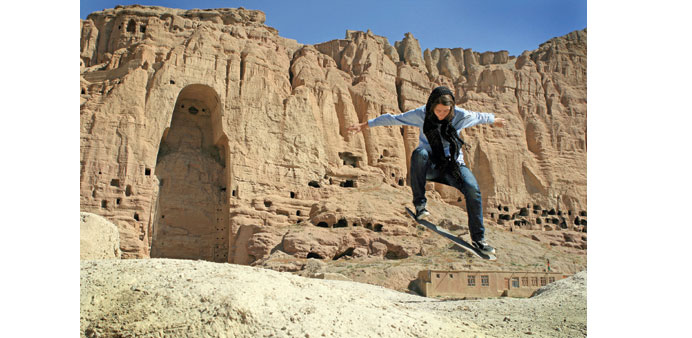“These girls remind us all of how even something as simple an hour of skating can be a highly liberating act.”
Guardian News Service/Kabul
With an oversized red helmet on her head and bright pink kneepads over her shalwar kameez, a little girl gazes directly at the camera. She stands atop a skateboard, ready to launch herself down a ramp at any second.
This is not just a child at play. The battered skateboard at her feet is symbolic of more than a toy. The photograph, taken at a school in Kabul, Afghanistan, is one of a series, titled Skate Girls of Kabul, that has gone on display at the Saatchi Gallery this week.
Photographer Jessica Fulford-Dobson travelled twice to Afghanistan, in 2013 and 2014, to capture an unusual project set up in the outskirts of Kabul to give girls between the ages of five and 16 the opportunity to skateboard - in a country where they are not allowed on bicycles.
Skateistan was set up in Kabul in 2007 by Oliver Percovich, an Australian skateboarder. The award-winning NGO began as a grassroots initiative to create educational and personal empowerment opportunities for Afghanistan’s expanding young population (50% of the country are under 16), with skateboarding as a hook. The project works with about 400 students a week - 40% of whom are girls.
After reading about Skateistan in a tiny newspaper article in 2012, Fulford-Dobson became determined to document this story of female defiance in a country ridden with conflict.
“The first thing that comes to mind is this unexpected juxtaposition of a very conservative country with girls skateboarding,” she said. “And suddenly in my head I could just see swirls of fabric and these amazing outfits on skateboards and I knew I had to go out and see it for myself.”
“It wasn’t easy,” she added. “They were very protective of letting anyone from outside into the project. But once they realised I was coming out more as an artist than a journalist, they took a chance on me.”
The 300-odd girls attend the school three days a week, skateboarding in the afternoon as a reward for studying. Fulford-Dobson immersed herself in the school for a month for her photography project but, after classes at the school were suspended in 2013 because of an increase in bombings in the city, she returned in 2014 to complete the series.
“You’d see the girls, so nervous and timid to begin with, and then they’d go down the ramp and they’d be filled with this pride. It has an amazing power I could never have anticipated,” Fulford-Dobson said.
“It was swirls and the movement that I wanted to capture. Rather than just static images, I wanted to get some poetry into these pictures. So, in some of these pictures, you get more of a sense of them floating.”
The exhibition at the Saatchi Gallery will also feature sound installations of recordings that Fulford-Dobson made when the girls were skateboarding.
For Fulford-Dobson, a major motivation in pursuing the project was her desire to depict the women of Afghanistan as something other than victims of men, war and religious suppression. It was this powerful portrayal in one of her skater girl portraits that won second place at the prestigious Taylor Wessing Portrait Award, which was displayed at the National Portrait Gallery last year .
She said: “What I am trying to do is bring back an image of Afghanistan that sheds some light on the human beings in that country. There is a defiance in showing Afghan girls feeling free and liberated, even if it is just in this closed environment.”
“These girls remind us all of how even something as simple an hour of skating can be a highly liberating act,” she added. “It’s funny how a skateboard can become such an evocative symbol.”



